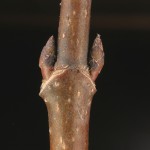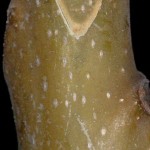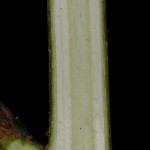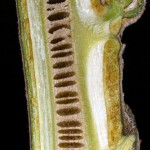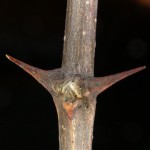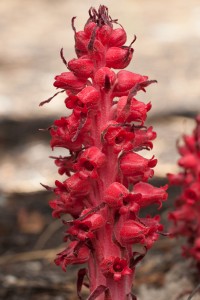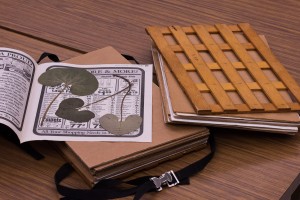How can one identify deciduous oaks, maples or other trees in winter? Botanists work with all kinds of plants that might be at various stages of growth and development or in different states throughout the year. And you can find all of these stages represented in our collections at the Herbarium, from seeds to seedlings, in growth and dormant. Many plants may be readily identified when they are in flower and/or fruit, or cone, as in conifers, or with spore cases, as in mosses and ferns. Many of these plants are photogenic, especially in Spring and during the bright summer days. After autumn however, they lose their colorful and identifying 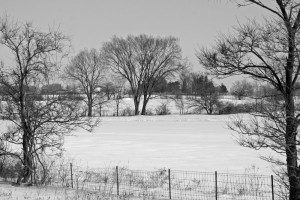 marks, but this does not mean that they lose their identity. They can be distinguished from each other, particularly if they are trees and shrubs and not members of large species groups. This may be difficult to the untrained eye, but botanists pay attention to them in their denuded states as well, or when they are just beginning to emerge from the ground, and just before producing flowers, cones or spore cases. Some individuals, particularly those working with wood and in forestry, need to know about dormant plants as they are likely to meet them in their field excursions in autumn and winter.
marks, but this does not mean that they lose their identity. They can be distinguished from each other, particularly if they are trees and shrubs and not members of large species groups. This may be difficult to the untrained eye, but botanists pay attention to them in their denuded states as well, or when they are just beginning to emerge from the ground, and just before producing flowers, cones or spore cases. Some individuals, particularly those working with wood and in forestry, need to know about dormant plants as they are likely to meet them in their field excursions in autumn and winter.
How do these plants look in winter and how are they identified? Here we present some notes and images of plant parts, particularly when these are in their least photogenic states, and show how botanists recognize them. One of the early works on this topic is a book by William M. Harlow, who produced an illustrated key to buds, twigs and fruits — in winter condition in the first two cases.
Leafless plant structures or parts. Some of the structures or parts that can be utilized in identifying plants in winter condition are buds and bud scale scars, leaf and stipular scars, fruit scars, the surface structure of twigs and the sectional outline, composition and shape of the inner part of the twig called pith, the locations of sharp outgrowths on the twigs (spines, thorns or prickles) and presence or absence of short shoots.
Buds that remain on the twigs in winter are embryonic structures; most are covered with scales, which are modified or thickened leaves. Buds are usually situated at the apex of the stem or branch, or laterally on a twig. There are also those that appear terminal but are not since growth in spring continues laterally and the buds open up and grow to be lateral branches or terminate into flowers. These are often called false terminal buds. Terminal buds are usually larger than the laterals.
Lateral buds appear in three arrangements: those occurring in 3’s or more are called whorled buds; those that occur singly along the twigs are called alternate buds, and those occurring in pairs at approximately 180o from each other are called opposite buds. In all of these, except the terminal bud or buds, leaf scars are situated beneath each bud.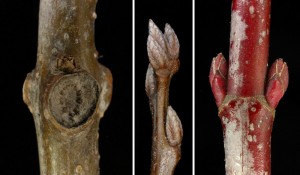
Bud scale scars are marks left from the previous season’s growth, resulting from the terminal bud. They appear as single lines at the end of last year’s growth. Leaf and stipular scars. When a leaf falls off in autumn, a narrow area, a scar, is left on the twig indicating  where the leaf was attached. These scars are of different types or shapes. Some plants have tiny, leaf-like structures on each side of a leaf. When these fall off in autumn, they also form scars on each side of the leaf scar. In some species, these form a circle.
where the leaf was attached. These scars are of different types or shapes. Some plants have tiny, leaf-like structures on each side of a leaf. When these fall off in autumn, they also form scars on each side of the leaf scar. In some species, these form a circle.
Twig surfaces, sectional outline and pith. Many plant twigs have pale white wart-like growths on their surfaces. These are called lenticels and are areas of loose cells that the plant utilizes to draw in or send out gases such as carbon dioxide and oxygen. Their presence or absence and their particular structure are applied in identifying twigs. Dissecting the twig cross-wise and along the long-axis displays the inner core and the cellular composition of the twig. Some may be filled with tissue, called pith. Others may be devoid of this. The pith may be solid or compartmentalized.
Pointed outgrowths on twigs. Spines and thorns arise from a region on the twig called the node while prickles may arise anywhere between two nodes. If a bud is found between the twig and the pointed outgrowth, then that pointed outgrowth is considered a spine as it represents a modified leaf. If the outgrowth is in the position of a bud and there is a scar beneath it, then it is a modified stem, called a thorn with the scar representing the position of the fallen leaf. Prickles are hardened or modified surface cells arising anywhere on the twig.
Short or spur shoots. These are branches that have been growing very slowly along any of the main branches. In terms of composition, they are similar to any of the twigs but have very condensed growth of leaves.  When the leaves fall off, they leave behind dense linear scars. They are often called spur shoots and are common in ginkgo (as shown here), cherry, apple and birch trees.
When the leaves fall off, they leave behind dense linear scars. They are often called spur shoots and are common in ginkgo (as shown here), cherry, apple and birch trees.
By examining the combinations of these features, as well as features such as color of bark and shape of buds, we are able to identify woody plants when they are dormant. This is true whether the plants are still growing outdoors or have been preserved as specimens in the collection.
About the authors: Mesfin Tadesse is Curator of Seed Plants in the OSU Herbarium and Robert Klips, who provided the photos, is Associate Professor in EEOB at the Marion Campus.


